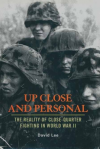
The Reality of Close-Quarter Fighting in World War II
What was it like to witness combat in World War 2? How did states prepare their soldiers? How did training and indoctrination transform volunteers into killers?
This book relies on the eyewitness accounts. David Lee guides the reader through veterans' stories of several key episodes: fighting between the BEF and the Waffen SS in 1940; the Commandos and the Dieppe Raid; the battle at Snipe in North Africa; the Italian campaign; the battles of Kohima and Iwo Jima; and Omaha Beach.
The veterans' stories are often graphic, but they capture how these (mostly) ordinary men adapted to the experience of combat. Lee's purpose with this book is not to shock. Instead, one of his main reasons for writing it is to compare the experiences of the veterans with the theory of S. L. A. Marshall's Men Against Fire. Men Against Fire suggests that only a small fraction of soldiers in combat actually shoot to kill. From the beginning of Up Close and Personal, Lee sets out to compare how veterans' recollections stack up against this idea.
The eyewitness accounts are the meat of this short book. You can read them for an illuminating and sobering journey into the hell of World War 2 and get your money's worth from these tales alone, without paying much mind to Lee's intellectual premise. The work Lee does in revisiting Men Against Fire is worth considering, however. The reluctant-killer thesis ties into the revolution in how how modern militaries prepare and indoctrinate their soldiers. Lee spends an entire chapter ("Enter the Commandos") on the creation of Britain's Commando training program during World War 2, and especially on its two master killers, William Fairbairn and Eric Sykes.
Fairbairn and Sykes met in the Shanghai Municipal Police prior to the war. According to Lee,
In the pre-war years Shanghai was probably the most violent city the world has ever seen, either before or since. The Shanghai Municipal Police Force, which patrolled a small waterfront area around the docks, seized more illegal drugs each year than all the American police forces combined. Murder, kidnapping, corruption and drugs were all commonplace and the police routinely had to arrest criminals armed with guns, knives and an expert knowledge of the Chinese and Japanese martial arts.
Lee, David. Up Close and Personal: The Reality of Close-Quarter Fighting in World War II (pp. 73-74). Pen & Sword Books. Kindle Edition.
Fairbairn and Sykes basically became expert assassins with their knowledge of guns, knives, and martial arts. The Fairbairn-Sykes fighting knife, the famous Commando knife, is their creation. The British SOE hired them and put them to work training Commandos how to kill. The chapter describes in detail the experiences of trainees attending the Commando school.
On the first morning after our arrival we met ‘Dan’ Fairbairn and ‘Bill’ Sykes. We were taken into the hall of the big house and suddenly at the top of the stairs appeared a couple of dear old gentlemen (we later discovered one was fifty-six and the other fifty-eight). Both were wearing spectacles and both were dressed in battledress with just a plain webbing belt. They walked to the top of the stairs and fell, tumbling, tumbling down the stairs and ended up at the bottom in the battle crouch position with a handgun in one hand and a fighting knife in the other. A shattering experience for all of us.
Lee, David. Up Close and Personal: The Reality of Close-Quarter Fighting in World War II (pp. 74-75). Pen & Sword Books. Kindle Edition.
Lee demonstrates how the special Commando training differed from the training of the regular forces (especially pre-war), and how this special training began to spread through the army, and the difference that made in the individual conduct of soldiers in action.
In addition to ruthless training regimes, Lee explores another crucial factor determining how soldiers fight the enemy: hatred. That's where Kohima and Iwo Jima come in.
Up Close and Personal is a swift and savage journey into the human experience at the sharp end, and the lessons learned in that dark place. It was a very affordable CAD $13 on Kindle, and if you're interested in a gritty perspective of World War 2, I recommend it. I also recommend it as a valuable perspective on S. L. A. Marshall's work. It's a quick read and thin on original research, but absolutely worth checking out.
Recommended - 3 out of 4
Up Close and Personal
by David Lee
Up Close and Personal
by David Lee
Thoughts on S. L. A. Marshall's Men Against Fire
If this subject interests you, here's a related piece of military research that I discovered years ago.
Link: Canadians Against Fire
It's a master's thesis by Robert Engen, who later used it as the basis for a book called Canadians Under Fire.
If you'll pardon the Canadian-centered nature of the article, I believe it can be applied to fighting men and women around the world.
Last edited:




